
NFPA (Fire) 70
- Comments Off on NFPA (Fire) 70
- NFPA-FIRE
Product Details
- Published:
- 08/12/2022
- ANSI:
- ANSI Approved
- Number of Pages:
- 917
- Note:
- This product is unavailable in Ukraine, Russia, Belarus




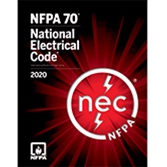
Click here to purchase
Please Note: NFPA has decided not to release the 2020 edition of the National Electrical Code as a PDF.
Prepare for the electrical challenges of tomorrow, today, with NFPA 70, National Electrical Code (NEC), 2020 edition.
The world never stops changing, so it’s crucial to keep learning how to keep it safe. Incorporated by reference in all 50 states and used across the globe, NFPA 70®, National Electrical Code® (NEC®), is the benchmark standard for electrical safety in residential, commercial, and industrial settings.
NFPA 70, NEC, was first published in 1897 and is continually put through a rigorous review process to keep it up to date with the most current industry practices, emerging trends, and the development and introduction of new technologies. The new NEC provides the latest requirements for safer and more effective electrical design, installation, and inspection, including provisions for wiring, overcurrent protection, grounding, and equipment.
Get up-to-code and prepared for the safety challenges of new sources of electrical power with the NEC, 2020 edition.
The revised and expanded NFPA 70, National Electrical Code, features state-of-the-art information for safe electrical practices for public and private buildings, homes and structures, outdoor yards and lots, utility equipment, installations that connect to the power grid, and consumer-owned power generation systems and equipment.
Content has been added, edited, and reorganized to address safety for workers, energy systems and electric vehicles, limited energy, and communication systems.
Impactful changes include:
The NEC, 2020 edition, introduces significant new requirements for:
Help protect life and property with the most relevant electrical requirements.
Get the cutting edge information you need to identify and overcome the latest hazards and complexities in electrical work. Order your copy of NFPA 70®, National Electrical Code, 2020 edition, today.



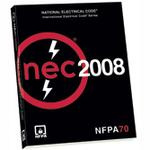
Click here to purchase
Industry-driven changes in the 2008 NEC® redefine electrical safety!
Be prepared to comply in the new era for electrical safety. The NEC protects the public by establishing requirements for electrical wiring and equipment in virtually all buildings. As the field’s most important document is revised based on industry needs, order your 2008 NEC to stay competitive and up-to-code!
Revisions in the 2008 National Electrical Code boost public safety, emergency preparedness, Code usability, and worker protection.
Only the 2008 NEC includes the latest rules for electrical installation in residential, commercial, and industrial occupancies. It also introduces:
Usability changes facilitate your work!
You’ll find greater consistency in grounding and bonding terminology…new shading behind revised text that lets you see what’s new at a glance…and new identifiers at the top of each page in the NEC index for speedier referencing.
You’ll work faster and more accurately with the CD edition:
The NEC is a must for electrical contractors, engineers, electricians, fire service professionals, safety officials, inspectors, and architects.



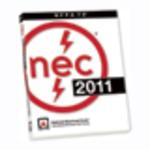
Click here to purchase
2008 Edition still available for purchase.
Technology is speeding ahead and so is the NEC®. Stay up-to-code with the 2011 National Electrical Code® direct from NFPA®.
Adopted in all 50 states, NFPA 70®: National Electrical Code has saved untold lives with comprehensive requirements for electrical wiring and equipment. When the Code advances to incorporate new technologies, you can’t afford to fall behind! You need the 2011 NEC to safeguard people and property, and avoid violations.
Major changes in the 2011 NEC meet consumer demand for alternate energy, green technologies, and IT equipment:
New requirements focused on workplace safety include:
Get first-time provisions on electrical installations over 600 volts.
New Article 399 incorporates requirements for overhead distribution systems for large electrical system users, such as school or business campus settings.
Bottom line: The 2011 NEC sets a new benchmark for safe electrical design, installation, and inspection. Order your copy in the bestselling Softbound format. If you’re involved with electrical safety, staying up-to-code is not optional — it’s essential! Order your Softbound Code for first delivery as soon as the 2011 NEC is published.




The most widely adopted element of a building code in the United States and the world, the NEC is the benchmark for safe and efficient electrical installations. Whether your jurisdiction adopts the 2002 Code immediately or down the road, you need to extend your knowledge and take advantage of the benefits right away, not months or years behind your peers in the electrical industry.
The 2002 edition contains over 400 revisions cover to cover!
The 2002 edition contains new safety improvements, the first requirements for emerging technologies, and new provisions for installing TVSS.
Our deluxe Looseleaf National Electrical Code includes a durable 3-ring binder, so it’s easy to add your own pages, or remove Code rules for copying or reference in the field.



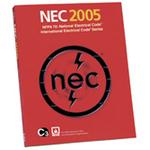
Every three years the National Electrical Code is significantly revised to keep pace with technology and enhance protection against electrical fire and shock hazards.
The 2005 Softbound NEC is loaded with solutions designed to provide better safeguards, add greater usability, and bring provisions in-line with technology trends. It’s a “must” for anyone who works with electric conductors or equipment. Revisions include:
With the CD-ROM edition you’ll be able to…
Electricity is part of everyday life, and so are the risks of fire and electric shock.
You’ll help improve electrical safety for millions of people with the latest edition of the NEC; the world’s most widely adopted safety code.



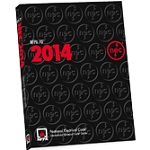
Click here to purchase
Adopted in all 50 states, NFPA 70: National Electrical Code has saved untold lives with comprehensive requirements for electrical wiring and equipment. Stay ahead in your industry and be the first to get the 2014 NEC Code Book! States will soon be adopting the 2014 NFPA 70: National Electrical Code (NEC) as the new benchmark for electrical design, installation, and inspection. Having the 2014 NEC can help you meet Code, avoid violations and re-dos, pass inspections, and keep people and buildings safe from electrical hazards. Hundreds of changes have been made to the Code. In response to input from the field, major NEC revisions will impact electrical installations in residential, commercial, and industrial occupancies. Keep your work on the cutting edge of new electrical technologies, you’ll find updated coverage on 600-volt systems, larger installations, renewable systems, small wind electric systems, DC systems, and electric vehicle charging systems.



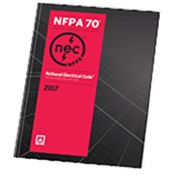
Click here to purchase
Hundreds of changes in the 2017 edition NEC® bring you up-to-code and ready to address new sources of electrical power.
Throughout the United States and around the world, NFPA 70®: National Electrical Code® (NEC) sets the foundation for electrical safety in residential, commercial, and industrial occupancies. The 2017 edition of this trusted Code presents the latest comprehensive regulations for electrical wiring, overcurrent protection, grounding, and installation of equipment.
NFPA 70: NEC has been published since 1897, and a rigorous process of review keeps it up-to-date with new technologies. In fact, more than 4,000 public inputs and 1,500 comments went into the 2017 NEC alone. Hundreds of updates and five all-new articles pave the way to a safe and efficient electrical future.
Major additions reflect the continuing growth in renewable power technology.The newest NEC addresses the advancement of privately owned wind and solar power generation and distribution equipment – including coverage of higher voltage systems that were once only the utilities’ domain. The new consumer role is a major factor in energy decentralization, and expanded NEC coverage is vital for designers, engineers, contractors, and AHJs.
Other NEC revisions protect the public and workers from deadly hazards.
Be prepared to protect lives and property in the ever-changing electrical landscape. Order the 2017 National Electrical Code.
Work with the latest requirements governing public and private buildings, homes, and structures; outdoor yards and lots; utility equipment; installations that connect to the power grid; and consumer-owned power generation systems and equipment. The 2017 NEC is better aligned with the safe work practices in NFPA 70E®: Standard for Electrical Safety in the Workplace®. (Softbound, Approx. 910 pp., 2017).



